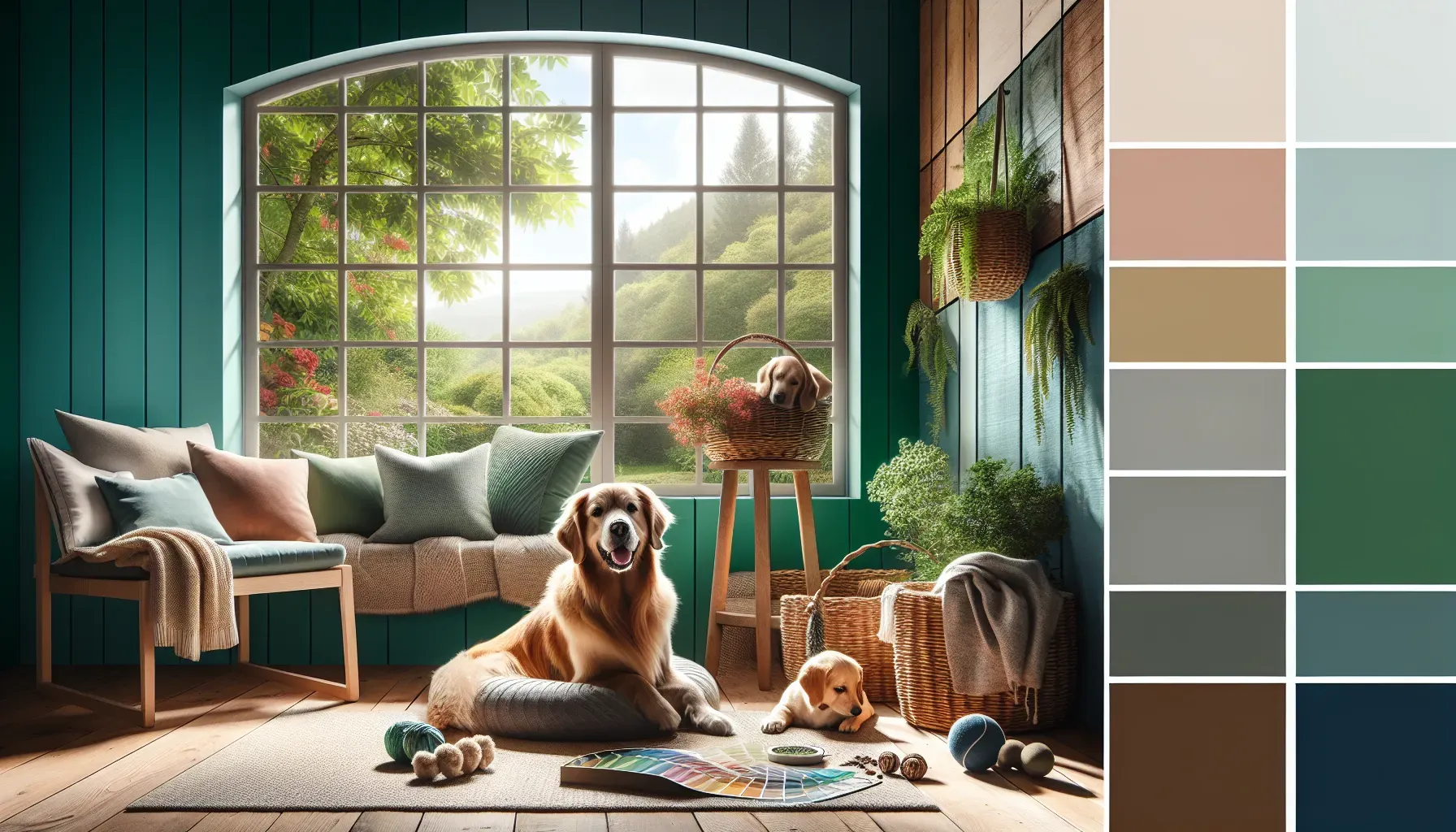Environmental Influences: Harnessing Green Spaces and Biophilic Design to Connect Pets with Nature through Color

Biophilic design, a concept centered on integrating natural elements into human environments, can greatly benefit our pets as well. When it comes to color choices for pet care spaces, adopting natural hues like greens, browns, and blues can create a calming atmosphere for pets. These colors mimic outdoor elements, enhancing their sense of connection with nature within indoor settings.
Biophilic Benefits for Pets: Integrating Natural Hues
Considering the preference of pets for exploring outdoor environments, incorporating earthy tones and organic hues helps in creating a balanced and harmonious living space for them. Additionally, the use of natural colors can reduce stress and anxiety in pets, ultimately contributing to their overall well-being.
Green spaces hold immense healing power not only for humans but also for pets. When designing pet care areas, such as sleeping or lounging spaces, introducing green hues through plants or other decorative elements can significantly impact the physical and mental wellness of pets.
The Healing Power of Green Spaces for Pets' Wellness
Exposure to green colors has been associated with reduced anxiety and increased relaxation in animals. Moreover, incorporating indoor plants or even green-colored bedding can provide pets with a sense of security and tranquility. This demonstrates the potential of natural colors to positively influence the emotional state of our pets.
Maintaining a balance between brightness and serenity is crucial when selecting colors for pet care environments. It's essential to avoid overly vibrant or intense colors that may overstimulate pets, leading to restlessness or unease. Instead, opting for muted shades inspired by nature can foster an environment conducive to relaxation.
Soft blues resembling clear skies or gentle browns reminiscent of earthy terrain are ideal choices for creating a tranquil atmosphere. By aligning the color palette with the calming aspects of nature, pet owners can promote relaxation and contentment within their pets' living spaces.
Balancing Brightness and Serenity in Pet Environments
Dogs are inherently curious creatures who thrive on exploration. When designing spaces tailored to canine companions, leveraging earth tones and nature-inspired hues becomes instrumental in nurturing their spirit of adventure.
Incorporating colors that mimic outdoor landscapes such as warm browns and leafy greens can encourage dogs to engage more actively with their surroundings indoors. A carefully curated color scheme reflecting natural elements not only supports their explorative tendencies but also enhances their overall comfort within the environment.
Nurturing Canine Exploration with Earth Tones
Cats are known for their keen awareness and curiosity about their surroundings. Therefore, when curating living spaces for feline friends, it's essential to strategically integrate natural colors that promote cognitive stimulation.
Subtle use of greys reminiscent of rocks or muted greens akin to foliage can engage cats' senses and mental acuity. By incorporating these natural hues within play areas or resting spots, pet owners can contribute to their cats' cognitive development by providing an environment that sparks their intellectual curiosity.
Enhancing Feline Environments with Natural Colors
In addition to benefiting pets, embracing natural colors in pet care spaces aligns with ecological principles by promoting sustainability and eco-friendliness. Opting for eco-friendly paint options that incorporate natural pigments not only serves the health interests of pets but also contributes to reducing the environmental impact of pet care practices.
Furthermore, utilizing sustainable materials in furniture or decor choices that resonate with natural color schemes fosters an ecological ethos within pet care design. This approach not only benefits pets but also advocates for responsible stewardship of the environment through mindful design practices.
Harnessing green spaces and biophilic design principles through thoughtful incorporation of natural colors can profoundly impact the well-being of pets. Whether it's creating a relaxing haven for dogs or fostering cognitive stimulation in cats, the intentional use of nature-inspired hues is pivotal in crafting enriching environments for our beloved animal companions.
Embedding Sustainability in Pet Care Design Choices
By embracing biophilic benefits and ecological ethos in design choices centered around natural hues, pet owners can elevate pet care spaces into nurturing sanctuaries that effectively connect pets with nature while promoting their overall health and wellness.
Frequently Asked Questions
Biophilic design integrates natural elements into environments, benefiting pets by creating calming spaces. Using natural hues like greens and browns mimics outdoor settings, enhancing pets' connection to nature and reducing stress and anxiety, ultimately promoting their overall well-being.
Green spaces significantly impact pets' physical and mental wellness. Incorporating green colors through plants or decor can reduce anxiety and promote relaxation. This exposure provides a sense of security, contributing positively to their emotional state and overall health.
To foster relaxation in pet care environments, it’s important to choose muted shades inspired by nature. Soft blues and gentle browns create a tranquil atmosphere, avoiding overly vibrant colors that may overstimulate pets, thus enhancing their comfort and contentment.
Earth tones are beneficial for dogs as they encourage exploration and engagement with their surroundings. Colors like warm browns and leafy greens mimic outdoor landscapes, nurturing dogs' adventurous spirits while enhancing their comfort within indoor spaces designed for them.
To stimulate cognitive development in cats, incorporating subtle greys and muted greens is effective. These colors engage their senses and curiosity, especially in play areas or resting spots, creating an environment that fosters mental acuity and intellectual exploration.
Utilizing natural colors in pet care design promotes sustainability by encouraging eco-friendly practices. Choosing paints with natural pigments and sustainable materials not only benefits pets’ health but also reduces environmental impact, fostering a responsible ethos in pet care environments.






